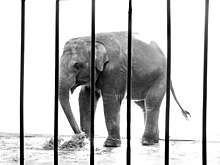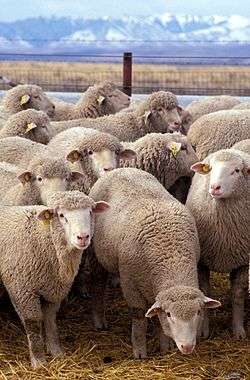Captivity (animal)
Animals that are held by humans and prevented from escaping are said to be in captivity.[1] The term is usually applied to wild animals that are held in confinement, but may also be used generally to describe the keeping of domesticated animals such as livestock or pets. This may include, for example, animals in farms, private homes, zoos and laboratories. Animal captivity may be categorized according to the particular motives, objectives and conditions of the confinement.

| Part of a series on |
| Animal rights |
|---|
|
|
Ideas |
|
Related |
|
|
History
Throughout history not only domestic animals as pets and livestock were kept in captivity and under human care, but also wild animals. Some were failed domestication attempts. Also, in past times, primarily the wealthy, aristocrats and kings collected wild animals for various reasons. Contrary to domestication, the ferociousness and natural behaviour of the wild animals were preserved and exhibited. Today's zoos claim other reasons for keeping animals under human care: conservation, education and science.
Behavior of animals in captivity
Captive animals, especially those not domesticated, sometimes develop abnormal behaviours.
One type of abnormal behaviour is stereotypical behaviors, i.e. repetitive and apparently purposeless motor behaviors. Examples of stereotypical behaviours include pacing, self-injury, route tracing and excessive self-grooming. These behaviors are associated with stress and lack of stimulation. Many who keep animals in captivity attempt to prevent or decrease stereotypical behavior by introducing stimuli, a process known as environmental enrichment.
A type of abnormal behavior shown in captive animals is self-injurious behavior (SIB). Self-injurious behavior indicates any activity that involves biting, scratching, hitting, hair plucking, or eye poke that may result in injuring oneself.[2] Although its reported incidence is low, self-injurious behavior is observed across a range of primate species, especially when they experience social isolation in infancy.[3] Self-bite involves biting one's own body—typically the arms, legs, shoulders, or genitals. Threat bite involves biting one's own body—typically the hand, wrist, or forearm—while staring at the observer, conspecific, or mirror in a threatening manner. Self-hit involves striking oneself on any part of the body. Eye poking is a behavior (widely observed in primates) that presses the knuckle or finger into the orbital space above the eye socket. Hair plucking is a jerking motion applied to one's own hair with hands or teeth, resulting in its excessive removal.[2]
The proximal causes of self-injurious behavior have been widely studied in captive primates; either social or nonsocial factors can trigger this type of behavior. Social factors include changes in group composition, stress, separation from the group, approaches by or aggression from members of other groups, conspecific male individuals nearby, separation from females, and removal from the group.[3] Social isolation, particularly disruptions of early mother-rearing experiences, is an important risk factor.[2] Studies have suggested that, although mother-reared rhesus macaques still exhibit some self-injurious behaviors,[4] nursery-reared rhesus macaques are much more likely to self-abuse than mother-reared ones.[2] Nonsocial factors include the presence of a small cut, a wound or irritant, cold weather, human contact, and frequent zoo visitors.[3] For example, a study has shown that zoo visitor density positively correlates with the number of gorillas banging on the barrier, and that low zoo visitor density caused gorillas to behave in a more relaxed way. Captive animals often cannot escape the attention and disruption caused by the general public, and the stress resulting from this lack of environmental control may lead to an increased rate of self-injurious behaviors.[5]
On top of self inflicted harm, some animals exhibit harm towards others and internal psychological harm. This can be exhibited in various forma, such as Orca whales, which never have killed a human in the wild, killing two of its own trainers. Psychological tics can also be identified, ranging from swaying to head bobbing to pacing. Continuous inbreeding is also bringing out mental disadvantages, such as crossed eyes and infertility.
Studies suggest that many abnormal captive behaviors, including self-injurious behavior, can be successfully treated by pair housing. Pair housing provides a previously single-housed animal with a same-sex social partner.[6] This method is especially effective with primates, which are widely known to be social animals.[7] Social companionship provided by pair housing encourages social interaction, thus reducing abnormal and anxiety-related behavior in captive animals as well as increasing their locomotion.[6]
See also
|
Animal husbandry Pet keeping
Animal rights
|
Wild animal keeping
|
References
- Definitions, 1911 CHAPTER 27 1 and 2 Geo 5; "...the expression “captive animal” means any animal (not being a domestic animal) of whatsoever kind or species, and whether a quadruped or not, including any bird, fish, or reptile, which is in captivity, or confinement, or which is maimed, pinioned, or subjected to any appliance or contrivance for the purpose of hindering or preventing its escape from captivity or confinement..."; Protection of Animals Act 1911; http://www.legislation.gov.uk/ukpga/Geo5/1-2/27
- Rommeck, Ina; Anderson, Kristen; Heagerty, Allison; Cameron, Ashley; McCowan, Brenda (2009). "Risk factors and remediation of self-injurious and self-abuse behavior in rhesus macaques". Journal of Applied Animal Welfare Science. 12 (1): 61–72. doi:10.1080/10888700802536798. PMC 4443667. PMID 17209750.
- Hosey, Geoff R.; Skyner, Lindsay J. (2007). "Self-injurious behavior in zoo primates". International Journal of Primatology. 28 (6): 1431–1437. doi:10.1007/s10764-007-9203-z.
- Erwin, J.; Mitchell, G.; Maple, Terry (1973). "Abnormal behavior in non-isolate-reared rhesus monkeys". Psychological Reports. 33 (2): 515–523. doi:10.2466/pr0.1973.33.2.515. PMID 4202533.
- Wells, Deborah L. (2005). "A note on the influence of visitors on the behavior and welfare of zoo-housed gorillas". Applied Animal Behaviour Science. 93 (1–2): 13–17. doi:10.1016/j.applanim.2005.06.019.
- Baker, Kate C.; Bloomsmith, Mollie A.; Oettinger, Brooke; Neu, Kimberly; Griffis, Caroline; Schoof, Valérie; Maloney, Margaret (2012). "Benefits of pair housing are consistent across a diverse population of rhesus macaques". Applied Animal Behaviour Science. 137 (3–4): 148–156. doi:10.1016/j.applanim.2011.09.010. PMC 4307811. PMID 25635151.
- Weed, J.L.; Wagner, P.O.; Byrum, R.; Parrish, S.; Knezevich, M.; Powell, D.A. (2003). "Treatment of persistent self-injurious behavior in rhesus monkeys through socialization: A preliminary report". Contemporary Topics in Laboratory Animal Science. 42 (5): 21–23. PMID 14510519.
